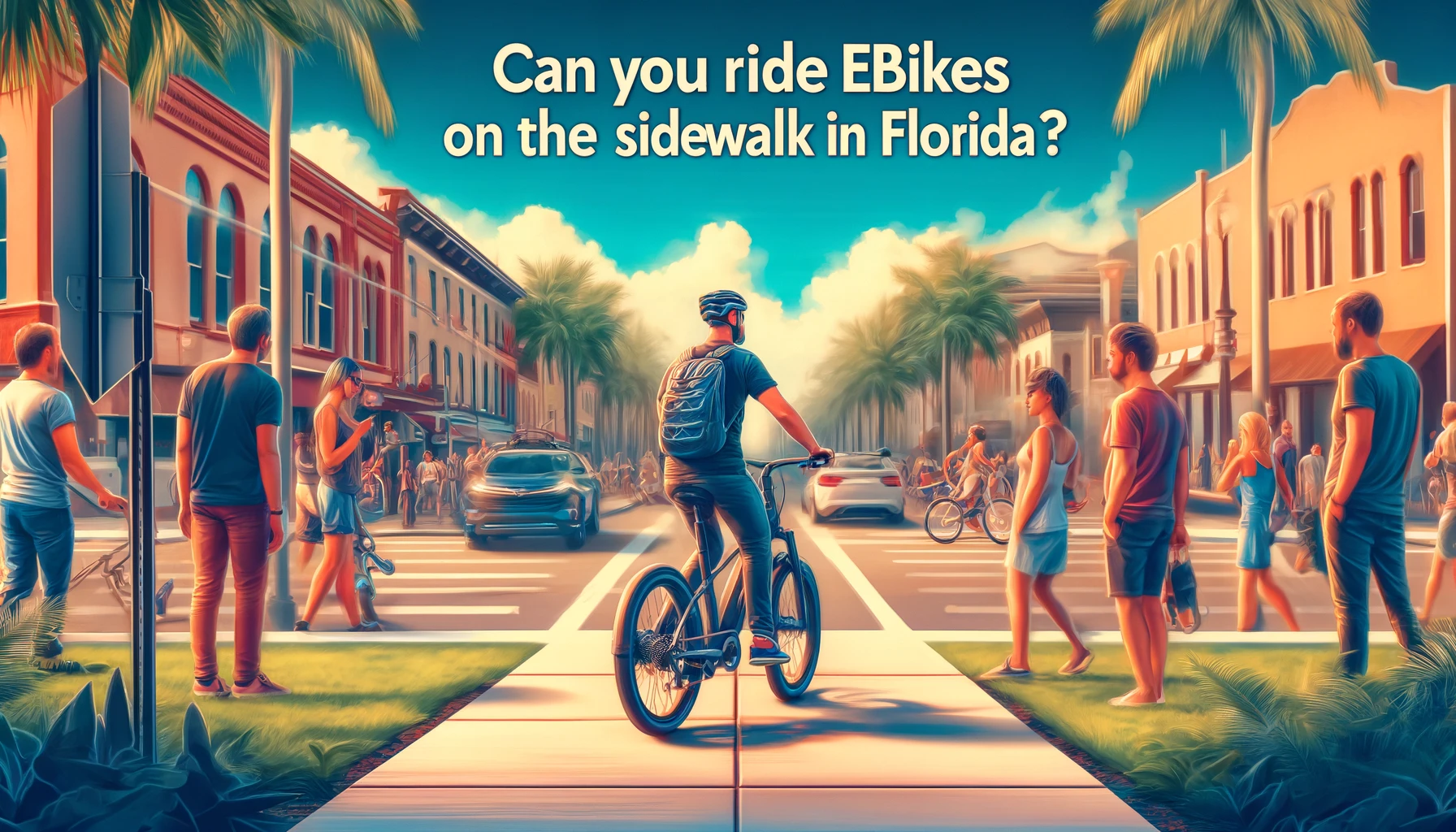In a state famous for its sunny days and vibrant energy, Florida beckons adventurers to explore its bustling streets and scenic byways. But what happens when the traditional mode of transportation just doesn’t cut it anymore? Enter e-bikes, the sleek, eco-friendly companions revolutionizing the way we navigate urban landscapes. As you gear up to embark on an electrifying journey through the Sunshine State, one question looms large: Can you ride e-bikes on the sidewalk in Florida?
As the hum of electric motors blends with the rustle of palm trees, the rules and regulations surrounding e-bike usage in Florida come into sharper focus. Navigating the sidewalks of this dynamic state astride your trusty e-bike offers a unique perspective, but treading this path requires a nuanced understanding of the legal landscape. Discovering the ins and outs of e-bike etiquette isn’t just about embracing a new form of mobility—it’s about harmonizing with the pulse of Florida’s urban rhythm while staying on the right side of the law. So, buckle up, fellow adventurers, as we dive into the intricacies of e-bike exploration in the Sunshine State.
Understanding E-Bike Classification in Florida
Before we delve into the regulations surrounding e-bike usage in Florida, it’s essential to understand the different classifications of e-bikes. In the state of Florida, e-bikes are classified based on their maximum speed and power output.
Class 1 e-bikes are equipped with a motor that provides assistance only when the rider is pedaling, and the motor ceases to provide assistance when the bike reaches a speed of 20 miles per hour. These bikes are often referred to as pedal-assist e-bikes.
Class 2 e-bikes, on the other hand, come with a throttle that allows riders to propel the bike without pedaling. Similar to Class 1 e-bikes, they also have a maximum speed of 20 miles per hour.
Lastly, Class 3 e-bikes have a higher maximum speed of 28 miles per hour but still require pedaling for motor assistance. These bikes are commonly known as speed pedal-assist e-bikes.
Now that we have a basic understanding of how e-bikes are classified let’s explore the regulations governing their usage on sidewalks and roads in Florida.
Regulations on Riding E-Bikes on Sidewalks vs. Roads

In Florida, riding an e-bike on sidewalks is generally allowed unless otherwise specified by local ordinances. However, it’s important to note that some cities may have specific rules prohibiting or restricting their use on sidewalks due to safety concerns or heavy pedestrian traffic.
If you choose to ride your e-bike on sidewalks where it is permitted, it’s crucial to prioritize pedestrian safety. Keep your speed in check and yield to pedestrians at all times. Remember that pedestrians always have the right of way.
When it comes to riding e-bikes on roads, the regulations are similar to those for traditional bicycles. E-bike riders must follow the same traffic laws as other cyclists and ride in designated bike lanes where available. If there is no bike lane, cyclists should ride as close to the right-hand side of the road as practicable.
It’s worth noting that Florida law does not require e-bike riders to have a driver’s license or register their e-bikes. However, riders must be at least 16 years old to operate a Class 3 e-bike.
Safety Tips for E-Bike Users in Florida
While exploring Florida’s vibrant streets and scenic routes on your e-bike, safety should always be a top priority. Here are some essential safety tips to keep in mind:
1. Wear a helmet: Protect your head by wearing a properly fitted helmet at all times.
2. Be visible: Equip your e-bike with front and rear lights, reflectors, and brightly colored clothing to enhance visibility, especially during low-light conditions.
3. Follow traffic rules: Obey traffic signals, stop signs, and yield right-of-way when necessary. Signal your intentions clearly when turning or changing lanes.
4. Stay alert: Keep an eye out for pedestrians, vehicles, and potential hazards on the road. Avoid distractions such as using your phone while riding.
5. Maintain control: Ride at a safe speed that allows you to maintain control of your e-bike at all times. Slow down when approaching intersections or areas with heavy pedestrian traffic.
Exploring Scenic Routes for E-Bike Tours in Florida
Florida offers an abundance of scenic routes perfect for exploring on your e-bike. Whether you’re seeking coastal views, lush nature trails, or vibrant cityscapes, there’s something for every adventurer. Here are a few popular routes to consider:
1. The Legacy Trail: Located in Sarasota County, this 10-mile trail winds through picturesque landscapes and offers glimpses of Florida’s natural beauty.
2. Key Biscayne Loop: This 16-mile loop takes you along the stunning coastline of Key Biscayne, offering breathtaking views of the Atlantic Ocean and Miami’s skyline.
3. Sanibel Island Bike Path: Explore the charming island of Sanibel on this 25-mile bike path that meanders through wildlife refuges and pristine beaches.
Remember to check local regulations and trail conditions before embarking on your e-bike adventure.
E-Bike Rental Options and Popular Destinations
If you don’t own an e-bike or prefer to rent one for your Florida escapades, there are plenty of rental options available throughout the state. Many cities offer bike-sharing programs that include e-bikes as part of their fleet.
Popular destinations for e-bike rentals include Miami Beach, Orlando, Tampa Bay, and Key West. These areas boast a variety of scenic routes and attractions that can be easily explored on an e-bike.
Importance of Proper E-Bike Maintenance in Florida’s Climate
Florida’s warm climate and occasional tropical storms can take a toll on your e-bike if not properly maintained. Here are some maintenance tips to ensure your e-bike stays in top shape:
1. Regular cleaning: Wash your e-bike regularly to remove dirt, sand, and salt residue that can cause corrosion.
2. Tire maintenance: Check tire pressure regularly and replace worn-out tires to ensure optimal performance and grip.
3. Battery care: Follow the manufacturer’s guidelines for charging and storing your e-bike’s battery. Avoid exposing it to extreme temperatures.
4. Brake inspection: Regularly inspect and adjust your e-bike’s brakes to ensure they are functioning properly.
By taking proper care of your e-bike, you can enjoy smooth rides and extend its lifespan.
Can E-Bikes Enhance Eco-Tourism in Florida?
E-bikes have the potential to enhance eco-tourism in Florida by providing a sustainable mode of transportation that reduces carbon emissions. With their electric motors, e-bikes offer an eco-friendly alternative to traditional vehicles, allowing visitors to explore Florida’s natural wonders while minimizing their environmental impact.
Eco-tourism destinations such as the Everglades National Park and the Florida Keys can benefit from promoting e-bike usage as a way for tourists to experience these unique ecosystems without contributing to pollution or disturbing wildlife habitats.
Advocating for E-Bike-Friendly Infrastructure in Florida
To fully embrace the e-bike revolution, it is crucial to advocate for e-bike-friendly infrastructure in Florida. This includes expanding bike lane networks, improving signage, and raising awareness about the benefits of e-bikes among policymakers and the general public.
By investing in safe and accessible infrastructure, Florida can encourage more people to choose e-bikes as a viable mode of transportation, reducing traffic congestion and promoting a healthier environment.
Embracing the Future of Urban Mobility in Florida
E-bikes represent an exciting future for urban mobility in Florida. With their ability to navigate congested streets with ease while reducing carbon emissions, they offer a sustainable solution to the challenges of transportation in a rapidly growing state.
As more people embrace e-bikes as a convenient and eco-friendly mode of transportation, Florida’s urban landscape will continue to evolve, creating a more vibrant and sustainable future for all.
Conclusion: Embracing the E-Bike Revolution in the Sunshine State
In conclusion, e-bikes offer an exhilarating way to explore Florida’s vibrant streets and scenic routes. While riding on sidewalks is generally allowed in Florida, it’s essential to be aware of local ordinances that may restrict or prohibit e-bike usage on sidewalks. When riding on roads, e-bike riders must follow the same traffic laws as traditional cyclists.
By prioritizing safety, exploring scenic routes, considering rental options, maintaining your e-bike properly, advocating for e-bike-friendly infrastructure, and embracing the future of urban mobility, you can fully immerse yourself in the e-bike revolution sweeping across the Sunshine State.
So grab your helmet and embark on an electrifying journey through Florida’s bustling cities and breathtaking landscapes with your trusty e-bike by your side. The possibilities are endless!

